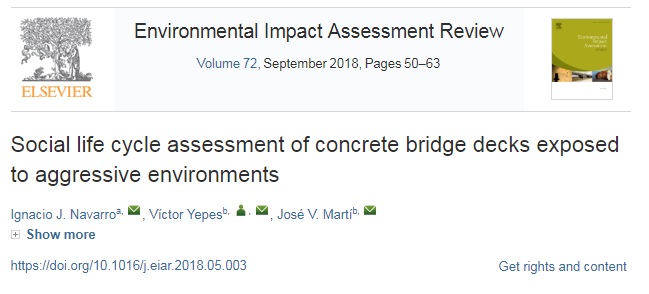 Acaban de publicarnos un artículo en la revista Environmental Impact Assessment Review (primer decil del JCR), de la editorial ELSEVIER, en el que se realiza una valoración del impacto social a lo largo del ciclo de vida de un puente de hormigón sometido a un ambiente costero, donde los clorhídricos suponen una agresión que supone un mantenimiento de la infraestructura.
Acaban de publicarnos un artículo en la revista Environmental Impact Assessment Review (primer decil del JCR), de la editorial ELSEVIER, en el que se realiza una valoración del impacto social a lo largo del ciclo de vida de un puente de hormigón sometido a un ambiente costero, donde los clorhídricos suponen una agresión que supone un mantenimiento de la infraestructura.
En el trabajo se analizan 15 alternativas diferentes durante el mantenimiento en relación con los impactos sociales. Los resultados indican que el uso de acero inoxidable en las armaduras y la adición de humo de sílice son preferibles a otras alternativas convencionales. Os dejo a continuación el resumen y las conclusiones.
Referencia:
NAVARRO, I.J.; YEPES, V.; MARTÍ, J.V. (2018). Social life cycle assessment of concrete bridge decks exposed to aggressive environments. Environmental Impact Assessment Review, 72:50-63. https://doi.org/10.1016/j.eiar.2018.05.003
Abstract:
Sustainable design of structures includes environmental and economic aspects; social aspects throughout the life cycle of the structure, however, are not always adequately assessed. This study evaluates the social contribution of a concrete bridge deck. The social performance of the different design alternatives is estimated taking into account the impacts derived from both the construction and the maintenance phases of the infrastructure under conditions of uncertainty. Uncertain inputs related to social context are treated through Beta-PERT distributions. Maintenance needs for the different materials are estimated by means of a reliability based durability evaluation. Results show that social impacts resulting from the service life of bridges are not to be neglected in sustainability assessments of such structures. Designs that minimize maintenance operations throughout the service life, such as using stainless steel rebars or silica fume containing concretes, are socially preferable to conventional designs. The results can complement economic and environmental sustainability assessments of bridge structures.
Keywords:
Social life cycle assessment; Chloride corrosion; Preventive measures; Guidelines; Concrete bridge; Sustainable design
Highlights:
- Social Life Cycle Assessment of different design strategies for bridge decks in marine environments.
- 15 design alternatives were studied and compared according to the Guidelines methodology.
- Less maintenance results in better social performance.
- Impacts during maintenance phase are main contributors to social performance
- Stainless steel and the addition of silica fume are socially preferable to conventional designs.
